Is your plant growing out of control? If so, repotting your leggy aloe vera plant can help it stay healthy, compact, and beautiful.
Don’t panic! These plants are pretty tough but easy to handle. This is what makes growing aloe vera such a delight. However, there are some things you’ll need to get right.
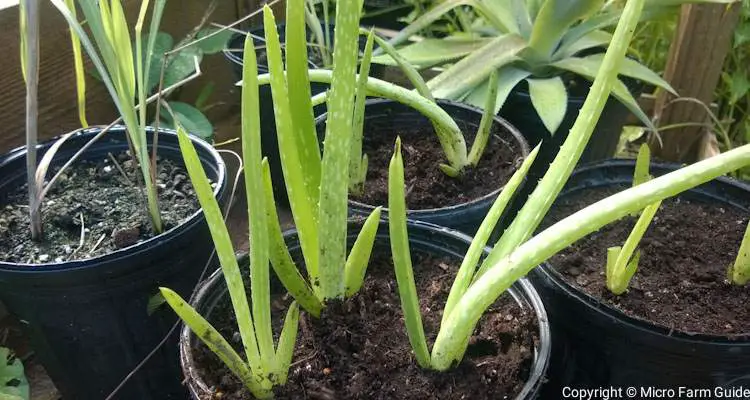
In this article, I will walk you through the process of repotting your overgrown aloe vera, including tips on pruning and fixing leaning plants.
How To Cut And Repot Aloe Vera
The main problem with aloe vera plants is that they tend to become top-heavy and can topple over time. As a result, we must prune and repot them periodically. With this in mind, let’s get started.
1. Uproot The Leggy Aloe Vera Plant
To begin, you’ll need to carefully uproot the overgrown plant. You can tilt the container and gently remove, or use a garden fork to dig around the root ball of plants in the ground.
Be on the lookout for small aloe pups, which grow at the base of the mature plant. Handle the flaccid leaves with care so as not to break them.
2. Inspect The Roots For Signs Of Disease
Remove some of the soil and check the roots carefully for signs of damage or fungal infection. Trim off any roots that appear to be rotting.
Carefully snip off the young aloe plants and place them aside. You can propagate aloe vera pups to make new plants later.
3. Prune Overgrown Roots And Old Leaves
Remove old, soft, and dry leaves from the plant. Then carefully remove lower drooping leaves by pressing downwards gently and peeling the leaf from around the stem.
Afterward, use a clean, sharp knife or shears to prune the overgrown roots. In some instances, you might need to cut the stem about 4 inches from the base of the plant. In this case, you can replant the upper and lower sections separately.
4. Prepare The New Pot
Prepare the new container by filling it with moist potting soil. Remember, aloe vera likes relatively dry, well-drained soils.
However, you’ll need to keep the soil moist but not soggy until the cuttings root successfully.
5. Transplant the Pruned Aloe Vera Plant
Transplant the aloe vera cutting into the container and fill it with potting mix. Press firmly until the plant stands upright. It would help if you staked larger plants until the roots can support themselves.
Alternatively, you can replant Aloe Vera in the ground, provided it receives enough moisture until it produces roots.
I usually transplant aloe vera outside toward the end of the rainy season. This way, they are rooted by the time the dry season arrives.
4 Ways To Fix Leaning Aloe Plant
If your aloe vera plant is leaning, there are a few things you can do to get it straight once again, depending on the age and size of the plant.
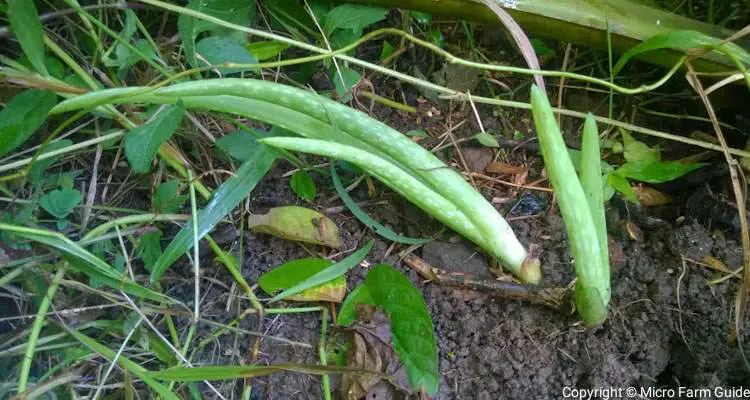
1. Increase Light And Decrease Watering Frequency
Drooping aloe leaves can be a sign of weakened plant structure. This is usually due to too much or insufficient light.
To fix this, you must relocate your plants to a well-lit location or prune surrounding vegetation to allow light to reach them.
Then check the moisture content of the soil. Chances are it will be moist. Allow the soil to dry for a day or two before watering again.
Younger plants usually correct themselves within a month or two without additional support.
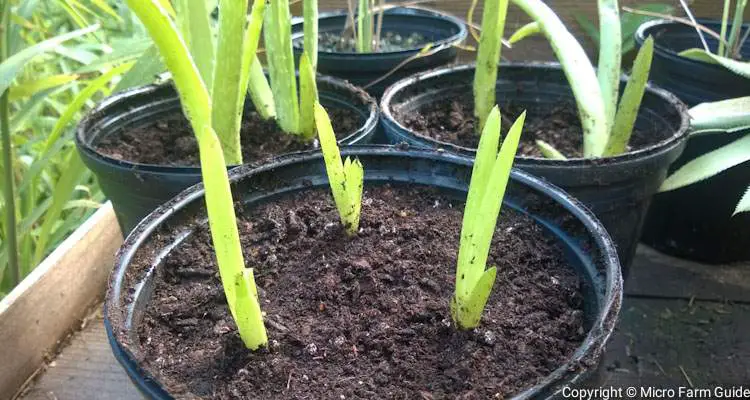
2. Prune Overgrown Aloe Vera Leaves
If your plants have become top-heavy, you will need to harvest some of the outer leaves.
In some cases, this is enough to take the strain off the stem and allow the plant to stand tall once again.
However, I usually mound soil around the base of the plant for additional support. This keeps the plant upright and also encourages the development of aloe pups.
3. Repot Large Aloe Vera Plants
You will need to uproot and repot large plants into suitable containers, as instructed above.
Use this time to harvest outer leaves and inspect for signs of disease.
Ensure that you pay attention to the water and light requirements of your aloe vera plants in the future.
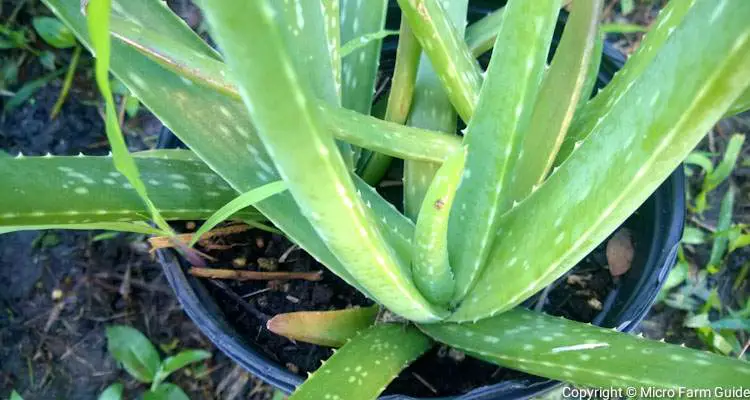
4. Stake Aloe Vera Plants
Sometimes, you’ll need to stake your aloe plants for additional support. This is done simply by placing at least two poles on the side where the plants are leaning.
These stakes should only be used as temporary measures and removed once the plant can stand upright by themselves.
However, it would be best if you repot top-heavy plants into larger containers. In comparison, smaller plants usually correct themselves over time.
How To Prune Aloe Vera Plants (Without Killing Them)
Aloe Vera is usually a slow-growing, compact plant. However, they tend to grow out of control if neglected or grown in unsuitable conditions. If this happens, you can prune your aloe plants using the steps below.
1. Inspect The Plant
First, you’ll need to inspect your Aloe plant and make a mental note of the extent of the overgrowth. Look for any signs of drooping, discolored leaves, or disease.
Examine the general shape of the plant and whether it is leaning. It would help if you also made a note of any leaves that are affecting the overall form or growth of the plant.
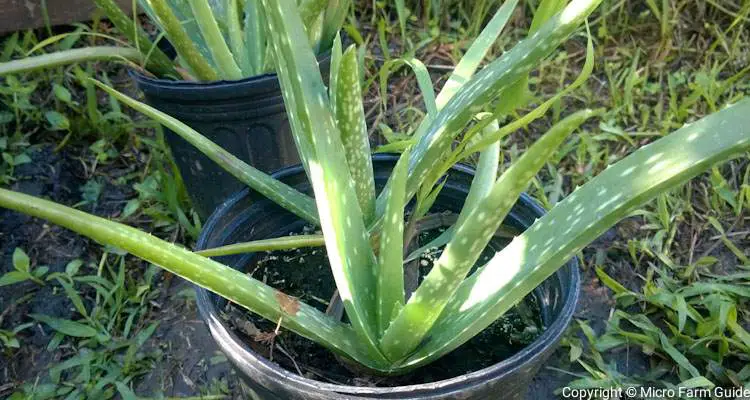
2. Remove Dead And Older Leaves
Remove any dry or dead leaves from the base of the plant. These usually tear off easily. However, be careful not to damage the upper leaves. If you see any soft yellowing leaves, you can remove these as well by pressing and peeling them from the stem.
Remove the older leaves from the plant. These are the thicker outer leaves. You can use a sharp knife to cut the older leaves as close to the stem as possible. Or press and peel them from the stem of the plant.
3. Separate New Pups
Use a sharp knife to separate Aloe Pups from the base of the plant. Then gently remove them from the soil by digging around the young plant.
You can use these plantlets to create new aloe plants. This is the most common way of propagating Aloe Vera.
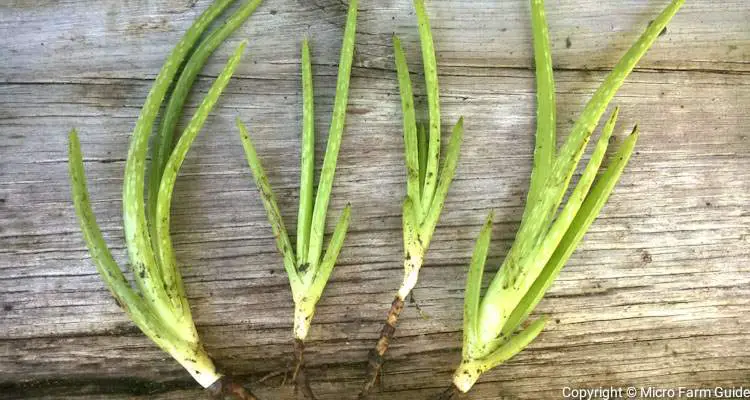
4. Trim Roots (If Necessary)
If your plant leaves are drooping and you suspect root rot, you should uproot the plant and scrutinize it.Trim any roots that show signs of infection.
This will cause some stress on your plant but will eventually stimulate new, healthy root development. Repot your plant afterward and monitor it over the following weeks.
Related Questions
Can You Cut Off The Aloe And Replant It?
You can cut off aloes at the stem and replant it successfully. However, this does not work with the leaves like other cactus plants, unless they have stem tissue attached.
What Causes Leggy Aloe Vera Plants?
The leading causes of leggy aloe vera plants are insufficient light, excess water, incorrect container size, and too much fertilizer.
